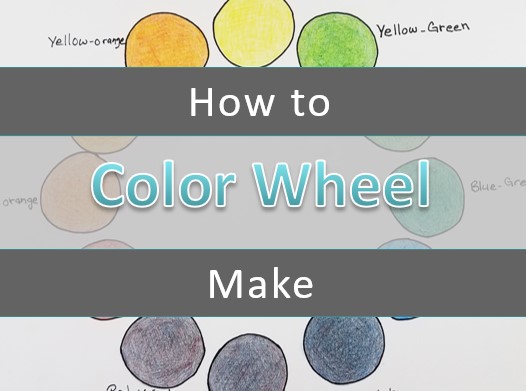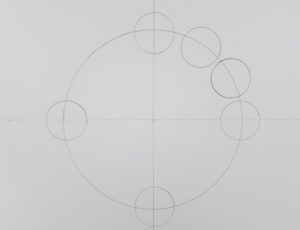Step by Step Color Wheels
Understanding color theory is important because color is one of the The 7 Elements of Art. And as artists we need to understand all 7 elements and how they work together.
This may not be the most exciting exercise to do, but the value you’ll get out of it will be immeasurable.
Today you will be learning how to draw a color wheel using only the three primary colors (yellow, red, and blue).
For this example I’ll be using Prismacolor colored pencils. But you could use a different medium as well.
* Some of the links in this post may be affiliate links. This means I receive small commissions for purchases made through these links at no extra cost to you.
Art Supplies
- White cardstock
- Pencil
- Thin black marker
- Ruler
- Drawing compass
- Circle template
- Colored pencils (red, yellow, blue)
- I used Scarlet Lake – pc923, Canary Yellow – pc916, Copenhagen – pc906
- Electric pencil sharpener
An Exercise In Blending Colored Pencils
During this lesson you will not only learn how to make a color wheel, but you will also learn how to blend colored pencils. I believe this is a highly valuable lesson that will help you achieve better results in your artwork when using colored pencils. I would consider this to be a beginner to intermediate technique.
The reason I say this is because most beginners will use only one color for their drawings instead of layering multiple colors. But since we are using only the primary colors and blending them to create secondary and tertiary colors, I would consider this to be only a slight advancement into the intermediate level of using colored pencils.
But, it is a step forward. So let’s get started with learning how to make a color wheel.
The Color Wheel Layout
The first thing we need to do is draw out the 12 hue color wheel. There are several different ways you could do this. I’m going to show you how to draw it out using circles, mostly because I think it has a cleaner look. This method is actually pretty easy if you have the right tools to draw it out.
Begin by dividing your paper into equal quarters. To do this find the half way points going both vertical and horizontal. Use a ruler to draw your lines. I used cardstock for this lesson, as I do for many of my drawings.
Using a compass, draw a circle from the center of your paper, leaving some room around the edges to write in the name of your hues (colors). My drawing compass was set at 3 inches and I’m using 8.5 x 11 inch paper.

Now you want to draw in all of your circles. I find that it’s easiest if you begin at the four spots where your center lines meet the circles. Choose one of the four, and line up the guides that are on the circle template. Using this template makes it really easy to line everything up.
Your first four circles will be directly across from one another.
Continue working on your color wheel layout by adding two additional circles between each of those first four circles. Work your way around, drawing your color wheel, until you have 12 circles. Each of these circles will represent one of the hues on your color wheel.
Cleaning Up Your Color Wheel
After all of your circles are draw, trace over them with a black marker and erase all of your pencil lines. You now have your color wheel all drawn out and you are ready to start adding color.
I should mention that the color wheel in this next image was drawn by tracing around the bottom of a glass bottle, because I couldn’t find my circle template. I didn’t like how uneven the lines were, so I bought another template to demonstrate a better way of making the color wheel.
Either way will work. It’s up to you to decide how much neatness matters in this exercise.

Primary Colors
We will start by filling in the primary colors. These are red, yellow, and blue.
Primary colors – are the colors used to mix all of the other colors. You can’t make a primary color from other colors.
Begin by filling in the circle at the top center with a yellow colored pencil. Take your time and layer the color to evenly fill your circle. You don’t want your colors to be shiny.
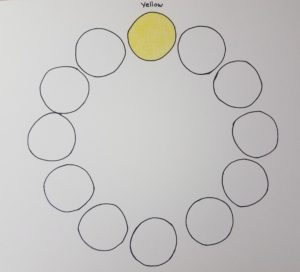
Tip – keeping your colored pencils sharp will help you get smoother colors. Using an electric pencil sharpener for your colored pencils will make your life a whole lot easier!
Next, fill in the section on your color wheel for blue. Skip 3 circles to the right of your yellow. This is where your blue should go. Fill your circle in using smooth, even pencil strokes.

Finish your primary colors by filling in the section for red. Skip 3 circles to the left of where you colored in your yellow circle. This is where your red should go.

As you can see, your primary colors form a triangle.
Secondary Colors
Secondary colors are made by mixing two of the primary colors together. These colors are green, orange, and violet (purple).
Therefore, the placement of the secondary colors on the color wheel is right between the two primary colors being mixed.
Using your yellow and blue colored pencils, fill in your green circle by layering the two colors. Add several layers of both colors, alternating between the two.
Be sure to fill the colors in evenly. The smoother your color are, the better your color wheel will look.
But be careful not to make them shiny. Use light, even pressure.

Follow the same process to fill in your circles for orange and violet. Place your orange directly between the yellow and red on your color wheel. And use those two colors to get orange.
Your violet circle will be directly between the red and the blue circles. And those two colors will be used to make your violet color.
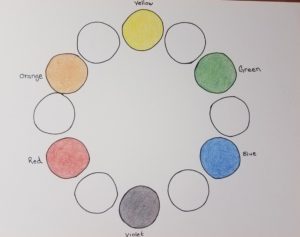
Tertiary Colors
These colors are made by combining one primary color with one secondary color, that are beside each other on the color wheel. There are six tertiary colors. They are yellow-green, blue-green, blue-violet, red-violet, red-orange, and yellow-orange.
The naming convention of theses colors is always the primary color, followed by the secondary color. And their placement on the color wheel is always directly between those two colors.
Blending the Greens
Begin by using your yellow and blue colored pencils to fill in the section between yellow and green. You will be making yellow-green. Since we are using colored pencils, and they don’t really mix, you will need to compare your new hue with the ones adjacent to it.
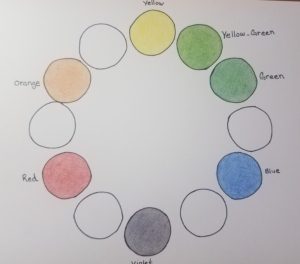
Continue to work your way around your color wheel. It’s probably easiest to go in order so you are working on making similar colors. So the next color will be blue-green.
It’s somewhat difficult to get a good blend with the colored pencils because they don’t actually mix together. Therefore, when you are making your colors, you will need to compare them to one another as you’re working your way through your color wheel.
Compare the yellow-green, green, and blue-green. You want the yellow-green to be more yellow than the green. And you want the blue-green to be more blue than the green.

Blending the Violets
Move onto your next hue and create your blue-violet color, then your red-violet. Again, compare the three violets to each other making sure the red-violet is more red than the violet. And that the blue-violet is more blue than the violet.

Blending the Oranges
Finish making your color wheel by filling in your red-orange and yellow-orange. Compare your three orange hues to ensure you have a good mixture of colors. When comparing your colors, add more of whichever color is needed to get a good blend of colors.
For example, if your yellow-orange looks too similar to your orange, then add a layer of yellow on top so it will appear more yellow.

Your color wheel is now complete and you’ve learned a lot of different concepts and techniques. You should have a full understanding of how each color is created, as well as what those colors (hues) are. This is a good step in the right direction to understanding color theory, which will be covered in a future post.
How to Make a Color Wheel for Beginners
Although learning how to make a color wheel might not be exciting, it’s an important of learning to make amazing works of art. If you don’t understand how colors are made, and how they work together, you’re artwork will be lacking. And nobody wants that.
Learn about all of the elements of art and you’ll see your art improve and become more interesting.
Grab your FREE Guide to the Elements of Art
More Tutorials on the Fundamentals of Art
- Learn to Paint a Color Value Scale
- How to Use Color in Art
- Space in Art
- What Are the 7 Elements of Art
- Mondrian Art Animals

